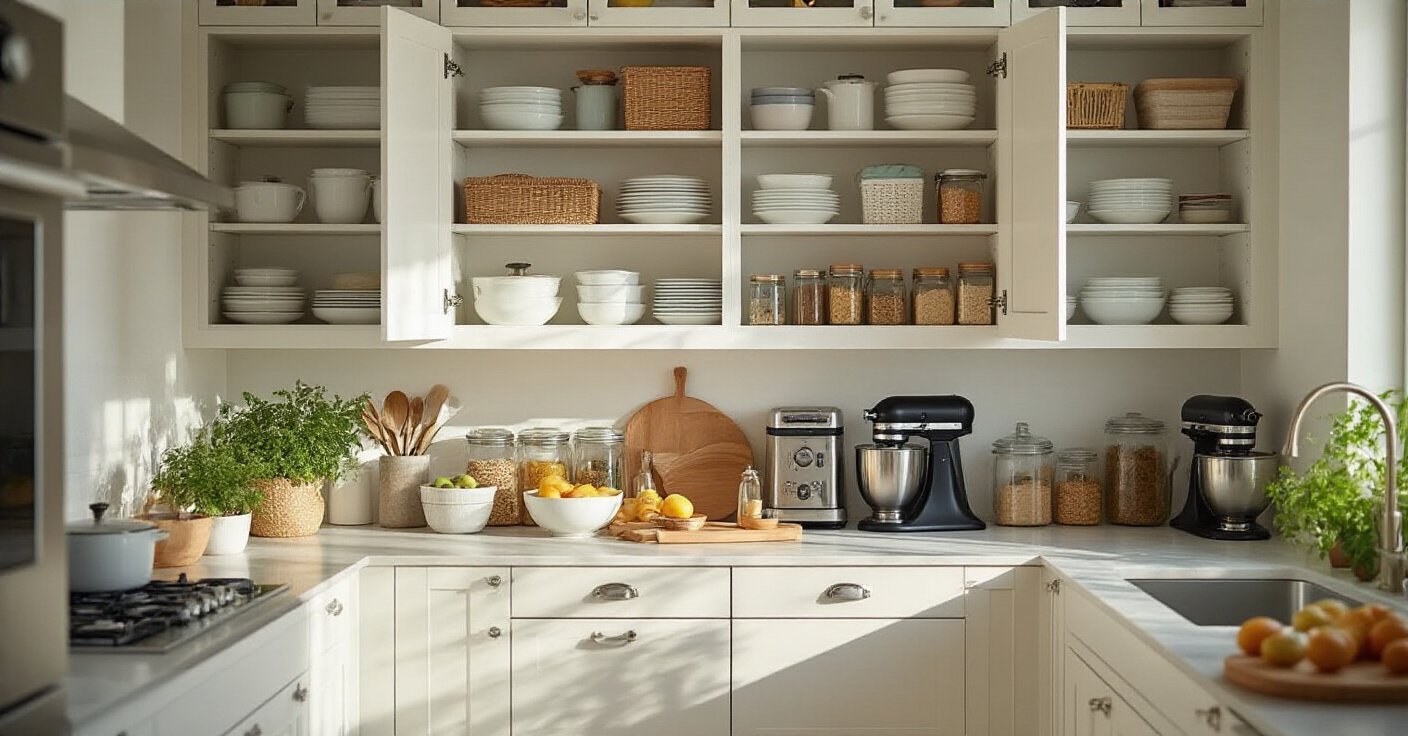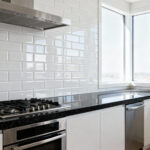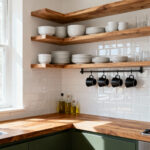Can we talk about my biggest pet peeve? It’s this idea that to solve kitchen clutter, you need a bigger kitchen. You need to knock down a wall, add an extension, and double your square footage. I see it on home renovation shows all the time, and it drives me absolutely wild. The problem is almost never the amount of space you have; it’s how you’re using the space you’ve got. Your existing cabinets are like prime, undeveloped real estate just waiting for a smart, sustainable plan.
This isn’t just about making your kitchen look tidy for a dinner party. It’s about fundamentally changing your relationship with your stuff and your space. A well-designed kitchen reduces daily stress, minimizes food waste, and saves you money. It creates a healthier environment by using better materials and encouraging calmer routines. This is the real story—how to make your kitchen work for you and for the planet, without spending a fortune on a remodel you probably don’t even need.
Foundational Steps: Strategic Planning for Your Kitchen Storage Cabinets
Before you even think about buying a single clear bin, you need a plan. This is the unglamorous part that everyone wants to skip, and it’s the single most important part of the entire process. Getting this right means every decision you make from here on out will be smart, intentional, and effective.
1. Conduct a Kitchen Inventory: Determine Exact Storage Needs
You know what people always ask me? “Where do I even start?” And I always give them the same answer: Start by dumping it all out. Seriously. The only way to know what you need to store is to know what you actually have. An inventory isn’t just about counting spoons; it’s a deep-dive audit of your consumption habits. You’re shopping your own home. It forces you to confront the three half-used bottles of olive oil, the quesadilla maker you haven’t touched since 2017, and the 14 mismatched Tupperware lids.
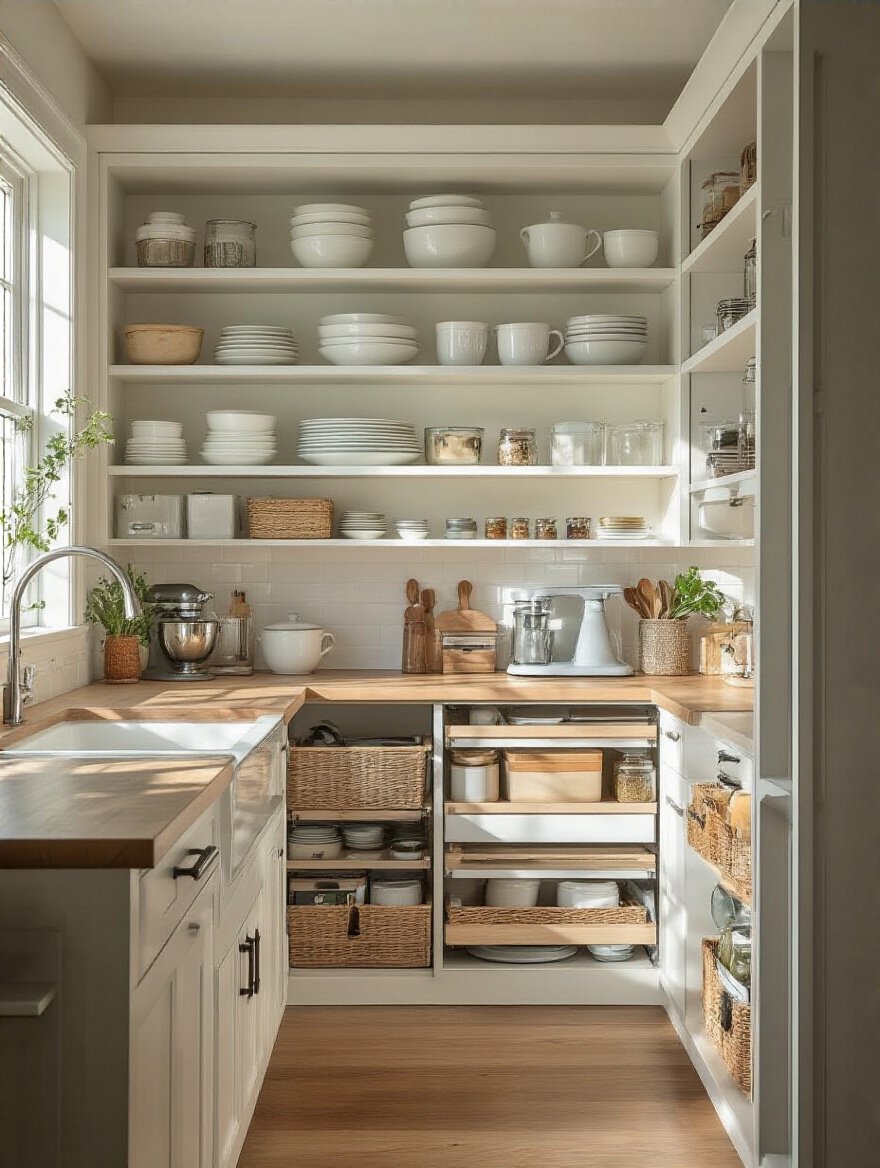
This single act is a powerhouse of sustainability. You immediately see your duplicates, your expired goods, and your impulse buys. I once had a client who discovered she owned five corkscrews. By simply decluttering, she freed up an entire drawer and made a pact to stop buying redundant gadgets. You will save money, reduce future waste, and instantly create 20-30% more usable space just by letting go of the stuff that’s only serving as a space-filler.
With a clear picture of what you’re keeping, you can move on to making sure those items are stored in a way that actually makes sense for how you live.
2. Map Your Kitchen Workflow: Optimize Cabinet Placement for Efficiency
Okay, now that you know what you’re storing, you need to figure out where it should live. This is about designing for your real-life movements, not just cramming things wherever they fit. A huge mistake is storing all your mugs on the opposite side of the kitchen from the coffee maker, or keeping your spices in a pantry across the room from the stove. Each of those unnecessary trips across the floor is a tiny drain on your time and energy, and they add up.
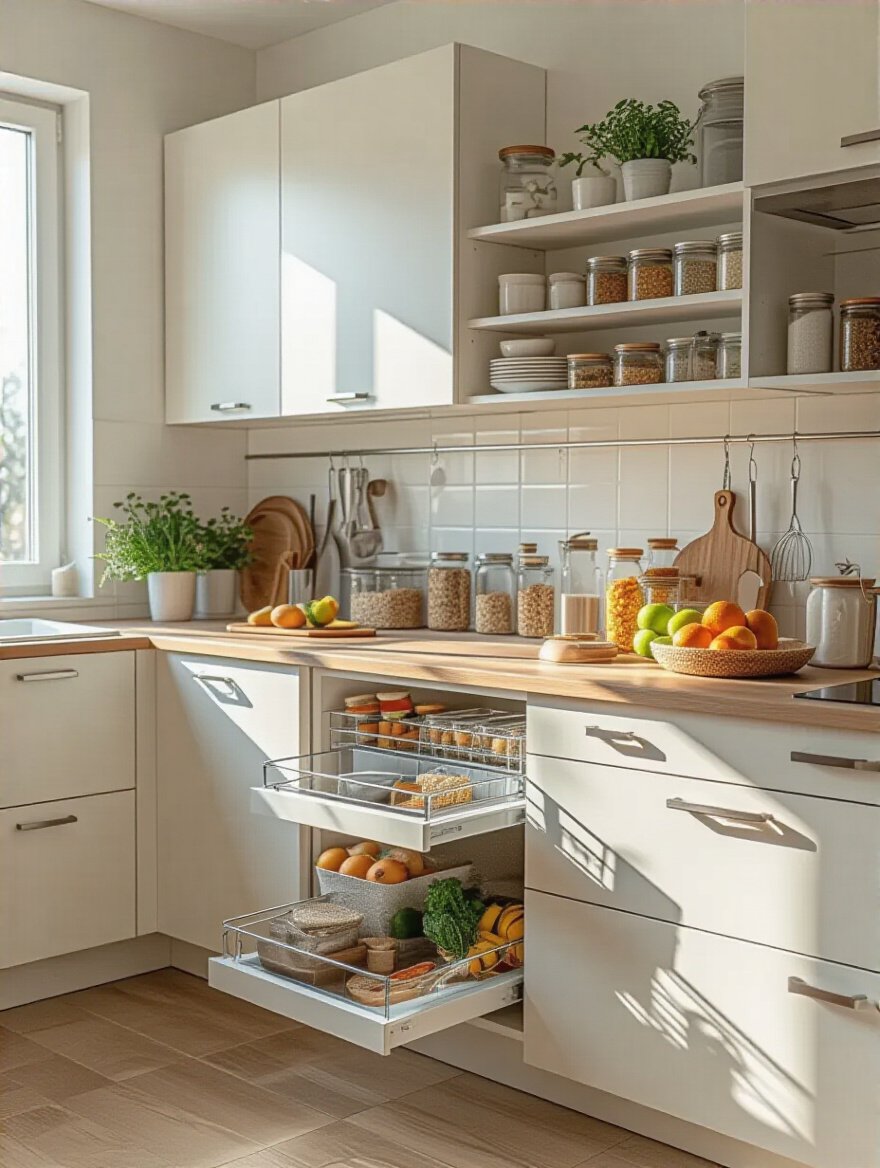
Think in terms of zones. Your “Brewing Zone” should have the coffee maker, mugs, coffee, and sugar. Your “Prep Zone” needs cutting boards, knives, mixing bowls, and oils right by your main stretch of counter space. By mapping your workflow, you create an ergonomic dance in your kitchen instead of a chaotic scramble. It’s a core principle of sustainable design: efficiency isn’t just about energy-star ratings, it’s about conserving your own human energy so that the tasks you do in a space feel effortless and enjoyable, not like a chore.
Once you know what you need and where you need it, you can start thinking about the cabinets themselves.
3. Evaluate Cabinet Styles: Match Storage Solutions to Kitchen Aesthetic
This is where my environmental science background gets really fired up. “Cabinet style” isn’t just about whether you like Shaker or modern flat-panel doors. It’s about choosing a system that will last. We live in a world of “fast furniture,” where kitchens are designed to be ripped out and replaced every decade. That is an environmental disaster. True sustainable style is about choosing quality materials and timeless design that you will love for 30 years, not 3.
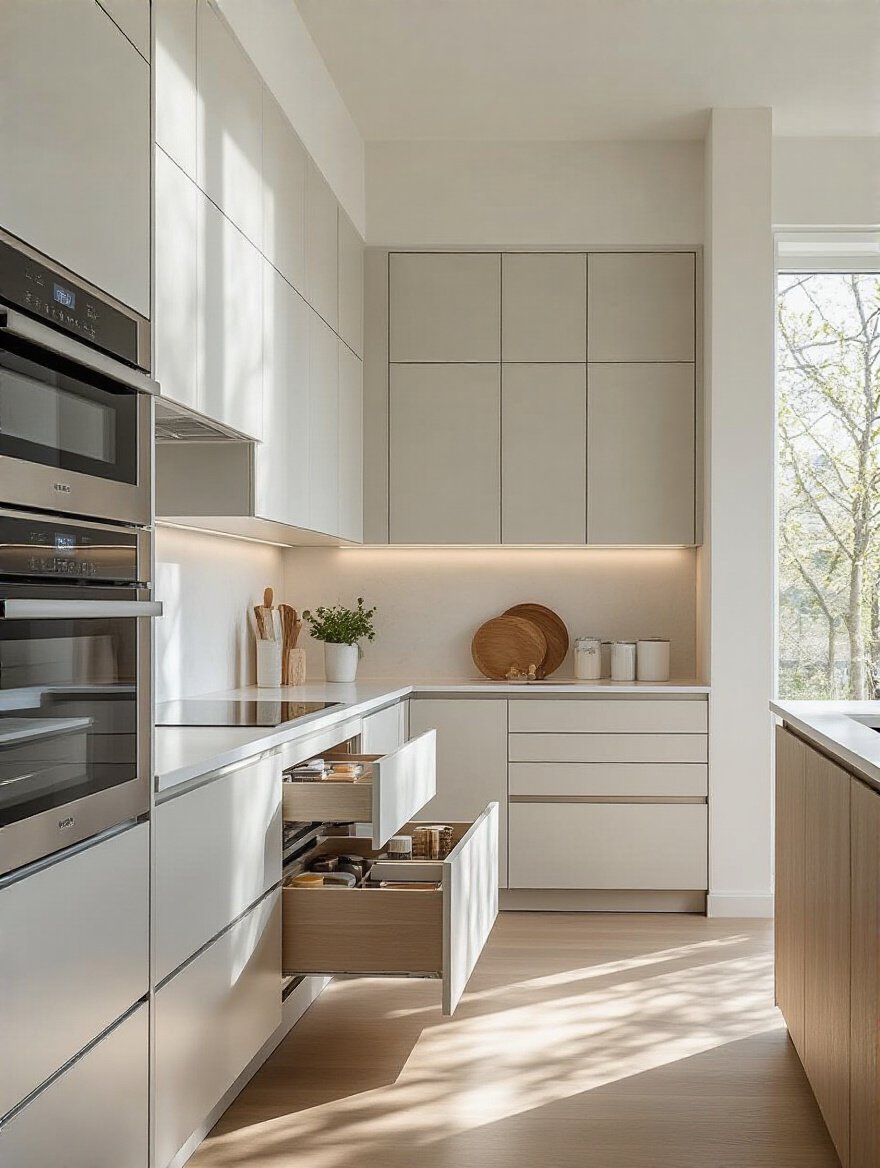
Look for solid wood or high-quality plywood boxes (not particleboard, which swells and fails) and low- or no-VOC finishes. These choices have a massive impact on your home’s indoor air quality and reduce the number of trees cut down and resources used over your lifetime. When you choose a cabinet style, think long-term. Is this a trend that will feel dated in five years? Or is it a classic, functional design that will serve your family for decades to come? Your most sustainable choice is the one you don’t have to replace.
Now for the part that terrifies everyone but is secretly the key to everything: the numbers.
4. Measure Accurately: Ensure Proper Fit for All Cabinetry Units
I used to think “measure twice, cut once” was just a catchy phrase for woodworkers. Then I watched a client have to send back $5,000 worth of custom pull-outs because they measured the cabinet opening but forgot to account for the interior hinge that stuck out by half an inch. Every single unit was useless. It was a complete waste of materials, fuel for shipping, and time. All because of a tiny oversight.
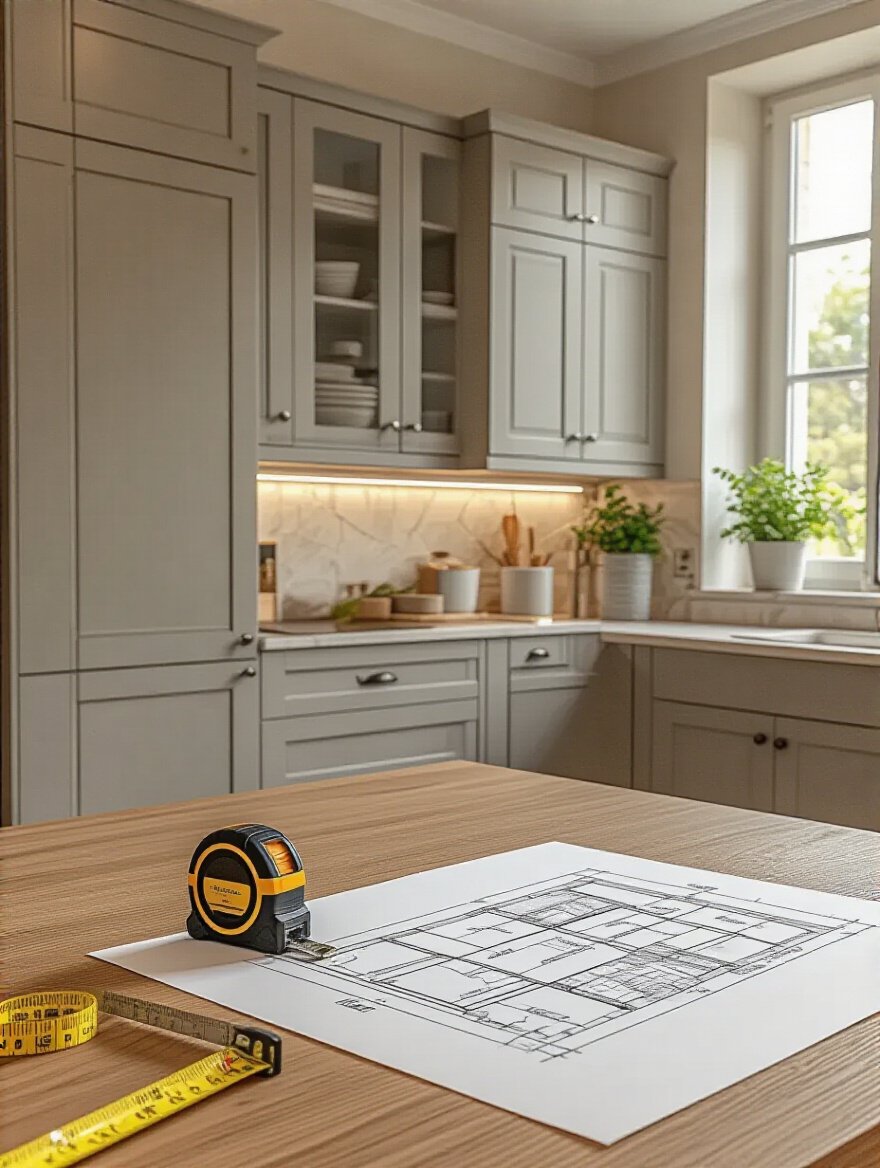
This is why you measure everything. And I mean everything. The width, height, and depth of the cabinet interior. The door opening. The location of hinges. The clearance you’ll need for a drawer to pull out past the oven handle. Use a real tape measure and write it down. Better yet, draw a little diagram. Taking an extra ten minutes to be obsessively precise will save you a world of hurt, money, and environmental waste down the line. It’s the ultimate act of respecting the materials you’re working with.
With your precise measurements in hand, you can start hunting for treasure in the most unlikely of places.
5. Identify Dead Space Solutions: Transform Awkward Gaps into Usable Storage
Picture this: You’re standing in your kitchen. I guarantee there are pockets of wasted space hiding in plain sight. That four-inch gap between the fridge and the wall? That’s not a gap, that’s a future slide-out spice rack. The toe-kick area under your base cabinets? That’s not just for aesthetics, it can be a shallow drawer for baking sheets or your pet’s food bowls. And the dreaded blind corner cabinet? That’s not a black hole, it’s an opportunity.
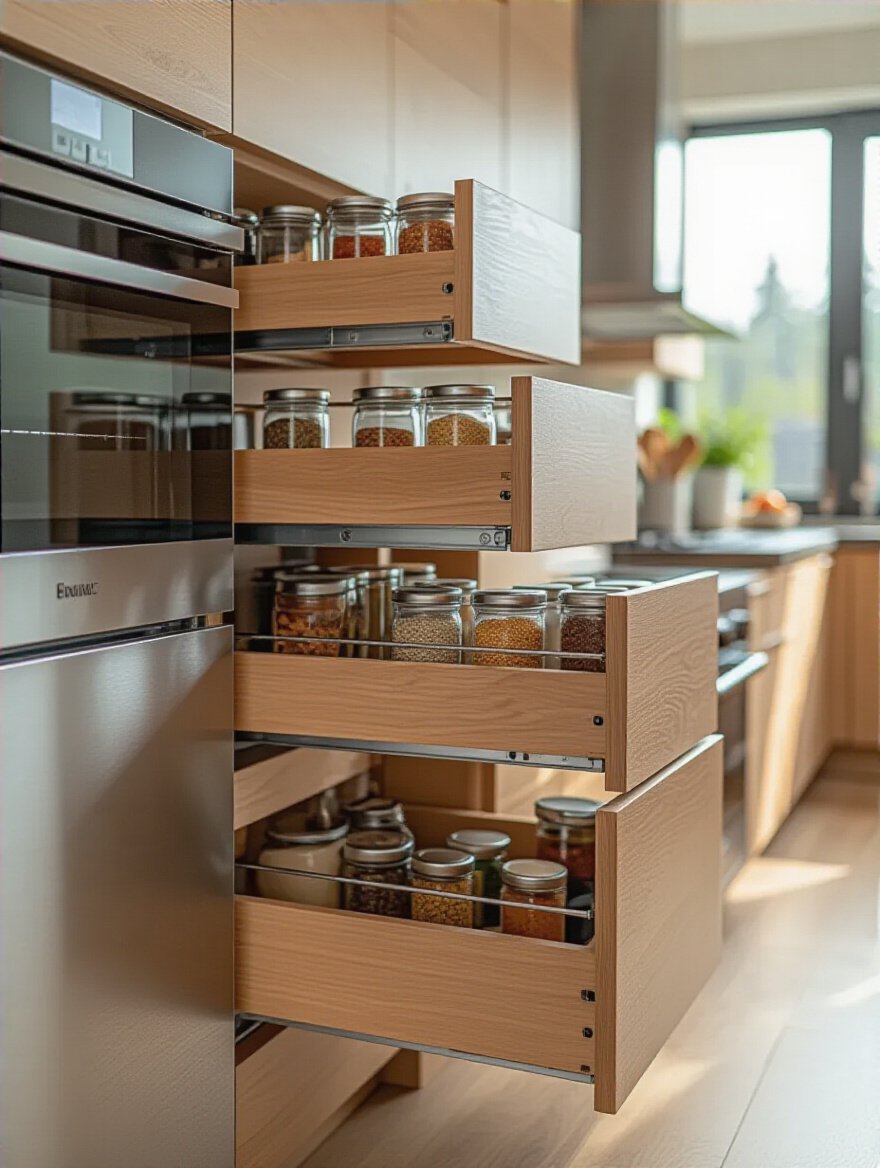
Using these dead spaces is the pinnacle of resourcefulness. You’re increasing your kitchen’s storage capacity without increasing its footprint. In my own small kitchen, I built a 6-inch-wide pull-out pantry on wheels that slides in next to my oven. It holds all my cooking oils, vinegars, and sprays. It cost me about $100 in materials and freed up an entire upper cabinet. It’s my favorite thing in the whole room because it’s a constant reminder that with a little creativity, you can make what you already have profoundly more functional.
Selecting Smart Cabinetry: Types and Features for Every Kitchen Need
If you’re in the position to choose new cabinets, this is your chance to build incredible functionality in from the ground up. This isn’t just about doors and boxes; it’s about a system designed for modern life.
6. Choose Base Cabinet Options: Maximize Below-Counter Functionality
Let’s be real, the standard base cabinet with a fixed shelf halfway up is a fundamentally broken design. You can only easily access the front half of it. Everything in the back is either forgotten, a pain to get to, or requires you to get on your hands and knees with a flashlight. It’s an ergonomic nightmare and a huge waste of space. The single biggest upgrade you can make is to prioritize drawers and pull-outs in your base cabinets.
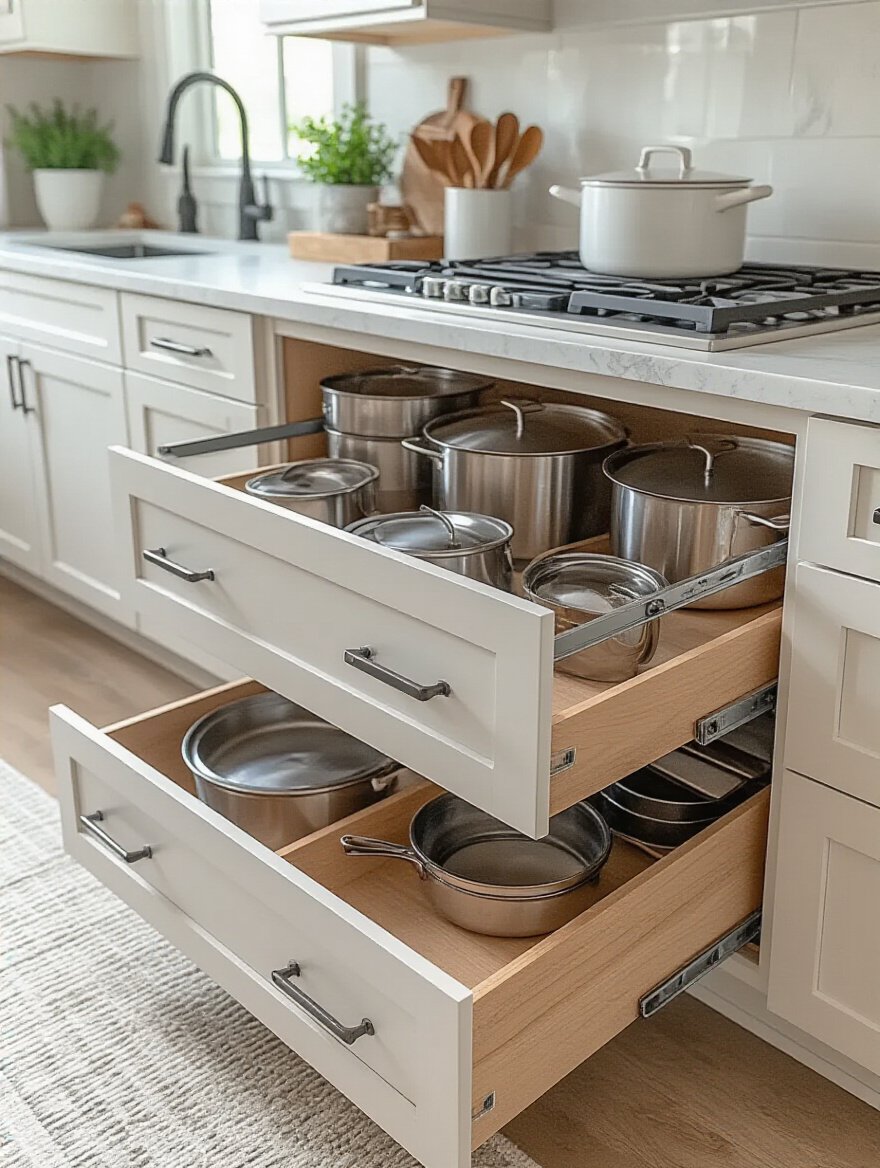
Deep, full-extension drawers bring the entire contents of your cabinet out to you. You can see everything at a glance, from pots and pans to stacks of food containers. This full visibility is a game-changer for reducing food waste and preventing you from re-buying things you already have. It’s also a key feature of “aging-in-place” design—creating a space that remains accessible and easy to use as you get older.
Once you’ve solved the lower half of your kitchen, it’s time to look up.
7. Optimize Wall Cabinet Height: Improve Accessibility for Everyday Items
There’s this “standard” height for hanging wall cabinets—18 inches above the countertop. But who is this standard for? A 6’4″ man and a 5’2″ woman have vastly different comfortable reach zones. Sticking to a rigid standard that doesn’t fit the primary user is just bad design. You end up with a top shelf that’s completely useless without a step stool, which means it becomes a cluttered graveyard for things you never use.

A truly sustainable and well-designed home adapts to its inhabitants. Take a moment to measure the primary user’s actual comfortable reach. Maybe your cabinets should only be 16 inches off the counter. Those two inches can be the difference between a shelf you can use every day and one you can’t. By customizing the height, you maximize the accessibility of the storage you paid for, ensuring every shelf is prime real estate.
Now let’s talk about consolidating one of the biggest sources of kitchen chaos: food.
8. Integrate Pantry Cabinets: Consolidate Food and Bulk Storage Efficiently
I used to think a pantry was a luxury, a walk-in closet just for food. I was wrong. A pantry is one of the most powerful organizational and waste-reduction tools you can have, and it doesn’t have to be a whole room. A single tall, dedicated pantry cabinet can revolutionize your kitchen. It centralizes all of your dry goods in one spot, ending the game of “which of these five cabinets has the crackers?”
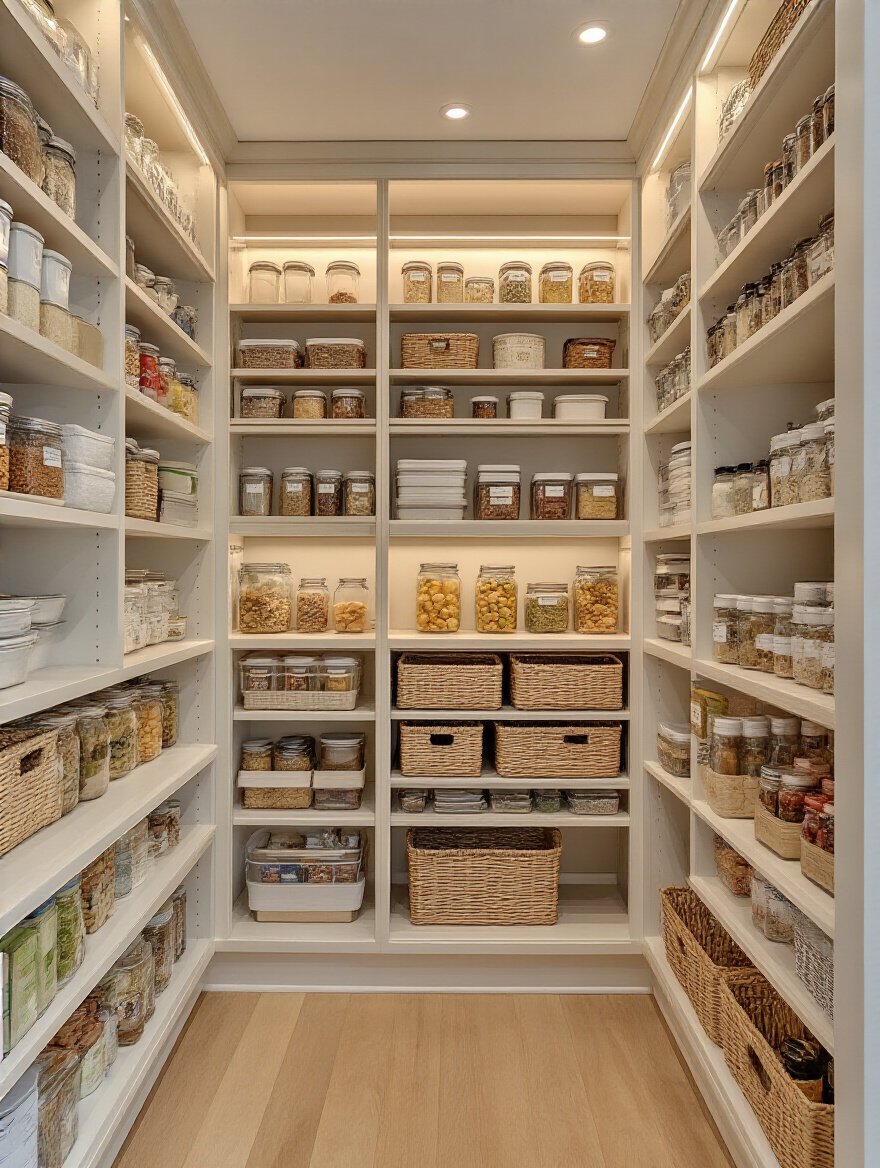
When you can see your entire food inventory at a glance—all the pasta, all the cans, all the cereals—your brain works differently. You meal plan more effectively. You use what you have before it expires. You stop buying duplicates. One of my clients reduced their monthly grocery bill by nearly 15% just by installing a pantry cabinet with pull-out shelves, because they finally knew what they owned. It’s a direct-impact tool for reducing household food waste, which is a massive environmental problem.
With bulk food handled, let’s get granular with the small stuff.
9. Consider Drawer Base Units: Organize Small Items with Easy Access
Okay, we’ve established that drawers are king. But not all drawers are created equal. This is about being strategic. Instead of one massive, deep drawer where everything jumbles together, think about a bank of drawers with varying depths. A shallow drawer for cutlery and cooking utensils. A medium-depth drawer for spices (laid flat or in a tiered insert) and linens. And a deep drawer for small appliances like a hand mixer or immersion blender.

By creating dedicated homes for specific categories of items, you bring order to the chaos. No more tangled whisks and spatulas. No more digging for the right measuring cup. You’re designing a system that makes cleanup a breeze because every single item has an obvious, intuitive place to go. This level of organization protects your tools, extending their lifespan, and brings a sense of calm to your daily routines.
Next, we get to the fun stuff—the James Bond-level cabinets.
10. Explore Specialty Cabinets: Incorporate wine racks or Appliance Garages
The modern kitchen is home to a lot of gadgets: a coffee maker, a toaster, a blender, an air fryer. Leaving them all out on the counter creates constant visual clutter, which contributes to mental stress. An “appliance garage”—a section of cabinetry that sits on the countertop with a lift-up or sliding door—is the perfect solution. It keeps your most-used appliances plugged in and ready to go, but hidden from sight.

This isn’t just about aesthetics. Keeping appliances tucked away protects them from dust and grease splatter, which can extend their functional life. The same goes for integrated wine racks, which store bottles properly and prevent them from rolling around. These specialty units are the epitome of “a place for everything, and everything in its place.” They’re a conscious design choice that says, “This space is intentionally designed for calm and order.”
Optimizing Interiors: Unlocking Every Inch of Your Kitchen Storage Cabinets
You don’t need new cabinets to have a new kitchen. The biggest transformations often happen inside the boxes you already have. These are the workhorses that turn frustrating spaces into functional powerhouses.
11. Implement Pull-Out Shelves: Eliminate Deep Cabinet Clutter Effortlessly
If you do just one thing from this entire list, make it this. Installing pull-out shelves in your deep base cabinets is absolutely life-changing. It solves the “black hole” problem instantly. Instead of items getting lost and forgotten in the dark recesses, everything glides out into the light where you can see and reach it. This is a non-negotiable for anyone who is tired of kneeling on the floor to find a stockpot.
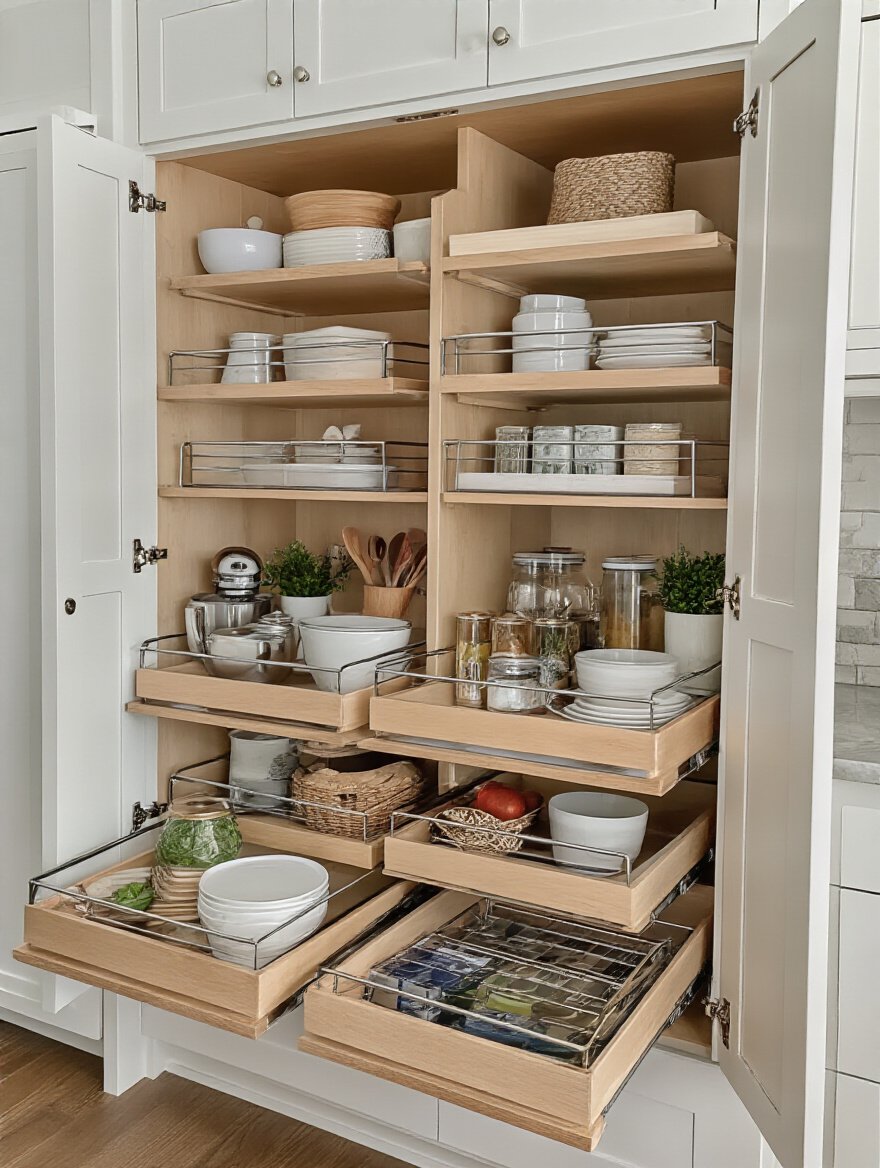
These can be retrofitted into almost any existing cabinet. They immediately double or even triple the accessible storage in that space. Suddenly, the back of the cabinet is just as valuable as the front. This is sustainability in action: you are dramatically increasing the utility of an existing asset rather than replacing it. It’s a simple upgrade with a massive return on investment, both in functionality and in your own sanity.
Now, let’s tackle the trickiest corner of the kitchen.
12. Utilize Corner Cabinet Solutions: Maximize Awkward Angle Storage Capacity
The blind corner cabinet is the undisputed champion of terrible kitchen design. It’s an awkward, cavernous space where large, heavy items go to die. But here’s the good news: engineers have solved this problem for us. There are incredible modern hardware solutions like “Magic Corners” or “LeMans units” that feature shelves that swing and pull completely out of the cabinet.
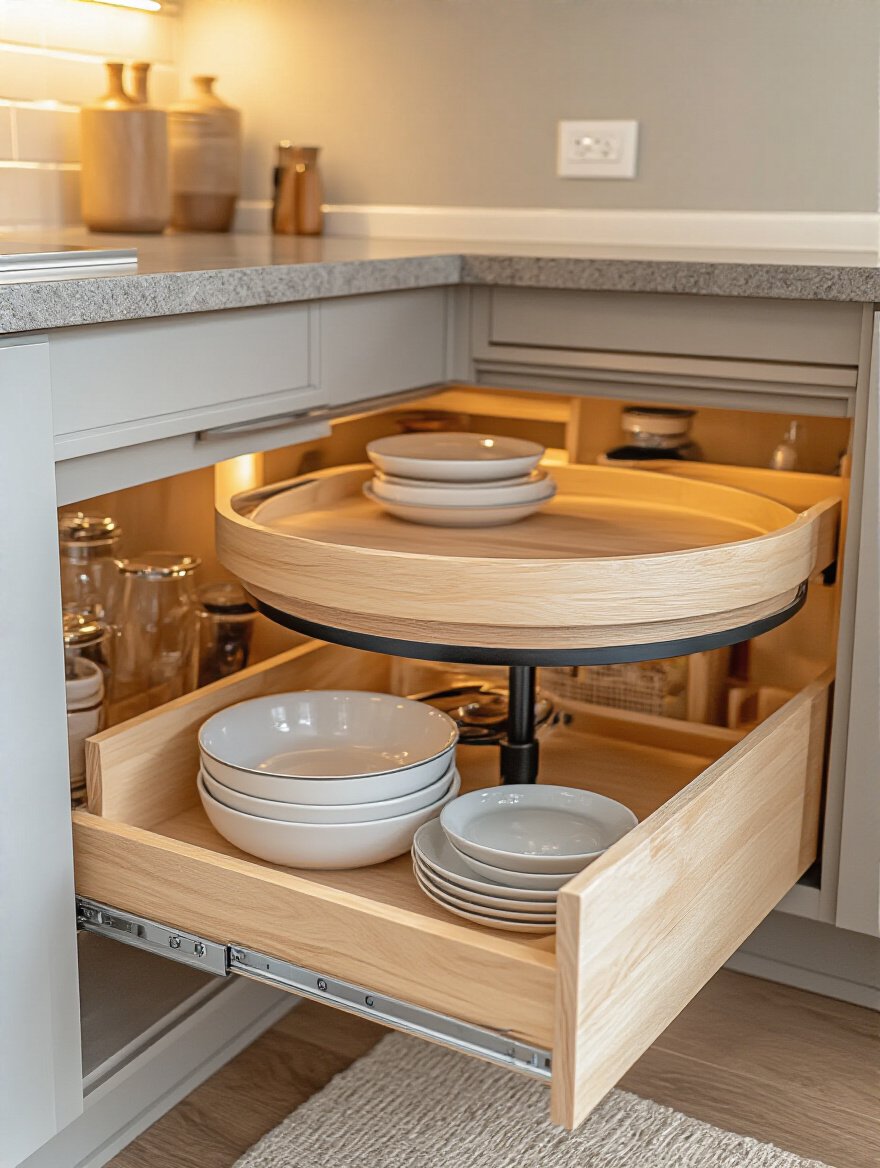
These systems are an investment, but they can reclaim up to 85% of that previously unusable space and make it fully accessible. This is where you store your stand mixer, your big pots, or your less-frequently-used appliances. By giving those bulky items a home in the corner, you free up more prime real estate in your easily accessible drawers and shelves for everyday items. It’s about making every single square inch of your kitchen pull its weight.
And don’t forget the most overlooked surface area in your whole kitchen…
13. Install Door-Mounted Organizers: Free Up Shelf Space Instantly
Your cabinet doors are vertical goldmines. That flat, empty space is begging to be put to work. A simple, slender rack mounted on the inside of a pantry door can hold your entire spice collection. A caddy on the door under the sink can organize your cleaning supplies. A holder can wrangle your aluminum foil and plastic wrap.
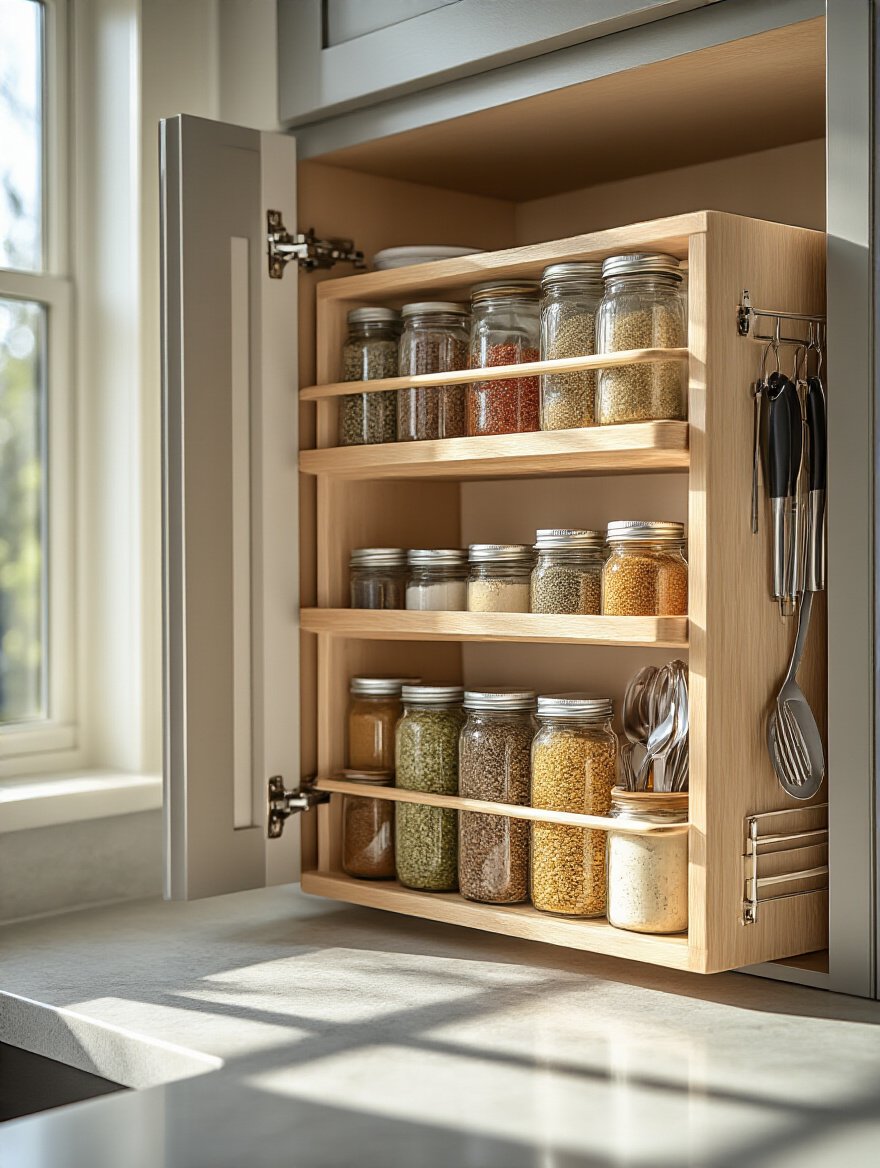
Each item you move onto a door is an item that is no longer cluttering up a valuable shelf. This immediately makes the items on the shelf more visible and easier to organize. It’s a brilliant, low-cost way to magically “create” more storage space without a single bit of construction. It’s about looking at your space with fresh eyes and seeing the potential that’s been there all along.
With things off the shelves, let’s bring some serious order inside the drawers.
14. Master Drawer Dividers: Keep Utensils and Gadgets Neatly Separated
A drawer without dividers isn’t a drawer; it’s a junk drawer. It’s where your potato peeler and your whisk go to get tangled up in a lifelong battle. Dividers are the answer. But forget those flimsy, sliding plastic trays. I’m talking about beautiful, adjustable bamboo dividers or custom inserts that create a specific, perfectly-sized compartment for every single thing.
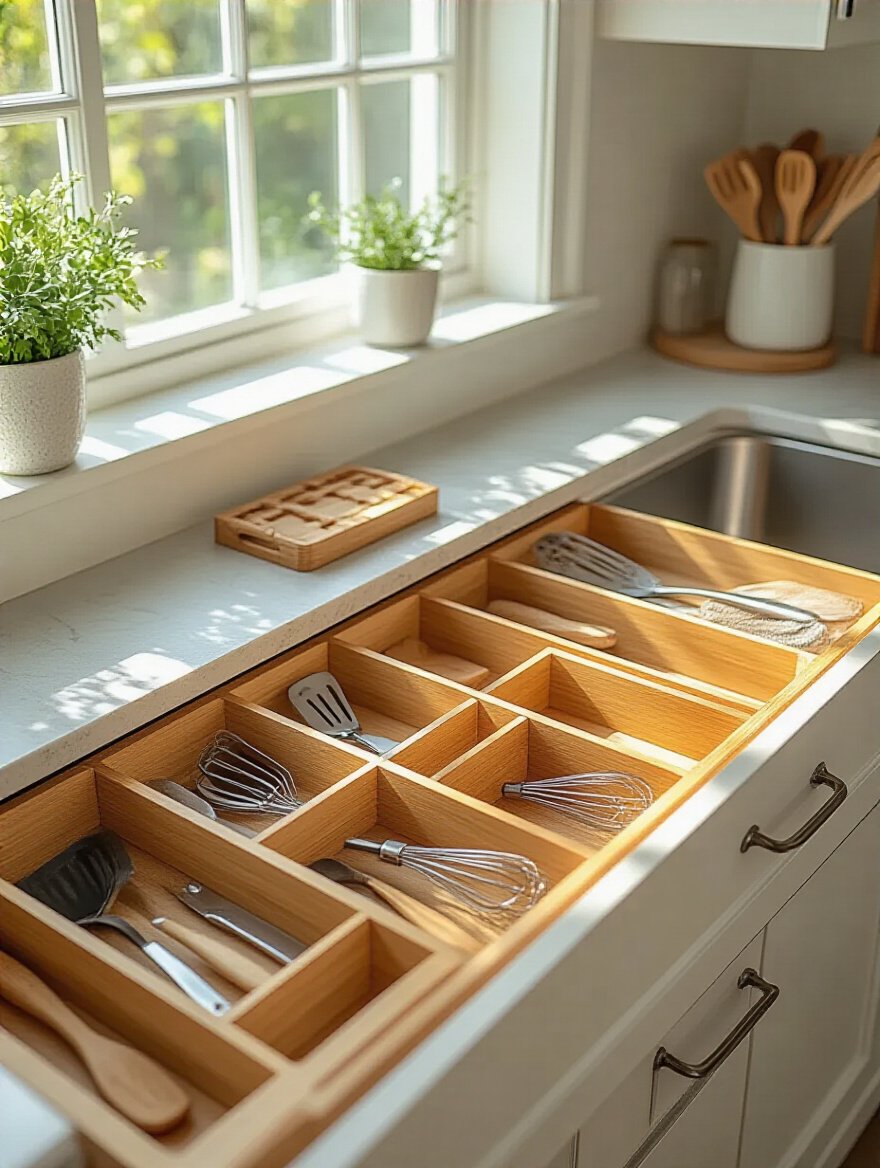
When every tool has a designated home, you protect your investment. Your knives don’t get nicked, your non-stick gadgets don’t get scratched, and everything lasts longer. This isn’t just about being tidy; it’s about respecting the tools you own and making them last. Plus, the calm that washes over you when you open a drawer and see perfect order is a daily reward in itself.
From dividers to risers, let’s look at another way to conquer space.
15. Optimize Vertical Space: Add Stackable Risers for Taller Items
Look inside your cabinet of plates and bowls. See all that empty air above your stacks? That’s wasted space. Simple wire or acrylic shelf risers are an incredibly effective way to create a second level of storage within a single shelf. You can put your large dinner plates on the bottom and your smaller salad plates or bowls on the riser. Instantly, you’ve doubled your usable surface area.
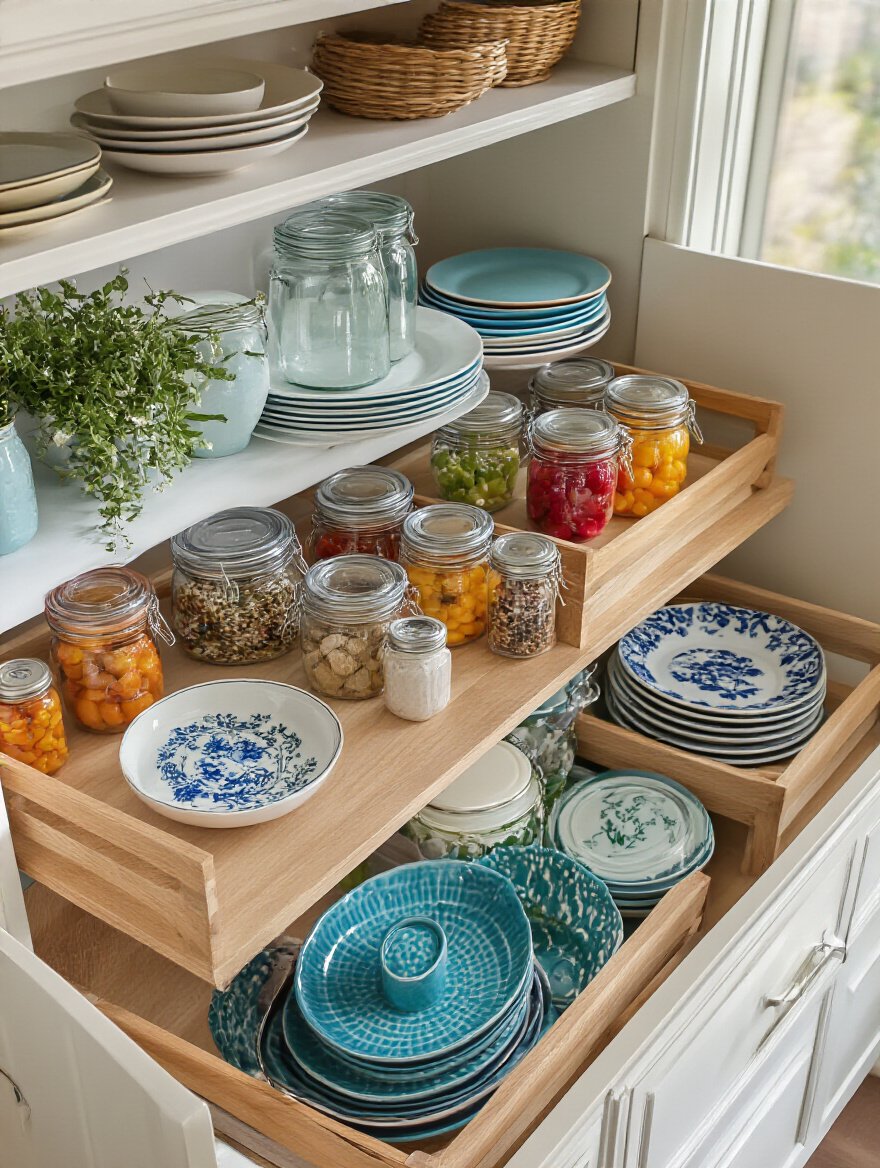
This strategy is fantastic for pantries, too. A riser allows you to see the cans in the back row without having to move the cans in the front. By creating tiers, you improve visibility, which—as we know—is key to reducing food waste. It’s such a simple, affordable hack that has a massive impact on both organization and resource management.
Smart Additions & Maintenance: Elevating and Preserving Your Cabinet System
You’ve got the layout, the internals are organized… now it’s time for the finishing touches that elevate the whole experience and protect your investment for the long haul.
16. Add Under-Cabinet Lighting: Improve Visibility and Workflow
This is my favorite “secret weapon” for making a kitchen feel more expensive and functional than it is. Most kitchens rely on a single overhead light, which means that when you stand at the counter, your own body casts a shadow right where you’re trying to work. Under-cabinet lighting illuminates your workspace directly. It’s Task Lighting that makes chopping safer, reading recipes easier, and the whole kitchen feel warmer and more inviting.
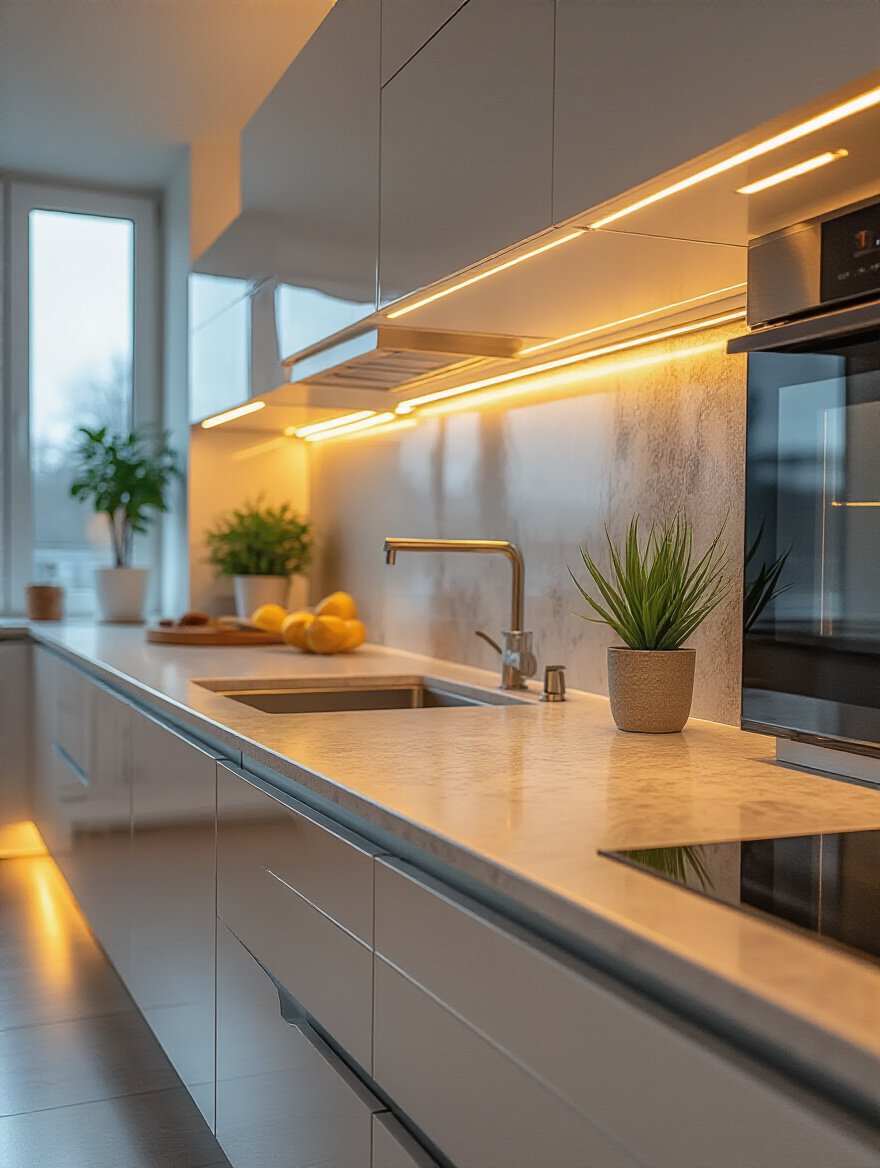
From a sustainability perspective, it’s brilliant. You’re using low-wattage, targeted LED lighting exactly where you need it, instead of blasting the entire room with high-power lights. It enhances safety, reduces eye strain, and adds a layer of ambient beauty to the room. It’s a relatively small investment for a massive upgrade in both function and atmosphere.
Now, let’s get truly modern.
17. Integrate Smart Cabinet Features: Incorporate Charging Stations or Sensors
The kitchen is the command center of the modern home, which means it’s also where all our devices end up. Instead of a tangle of cords cluttering up your countertop, dedicate a drawer to be a hidden charging station. It’s a simple project for an electrician (or a confident DIYer) to install an outlet or USB hub inside a drawer. You can then charge your phone, tablet, and headphones out of sight.
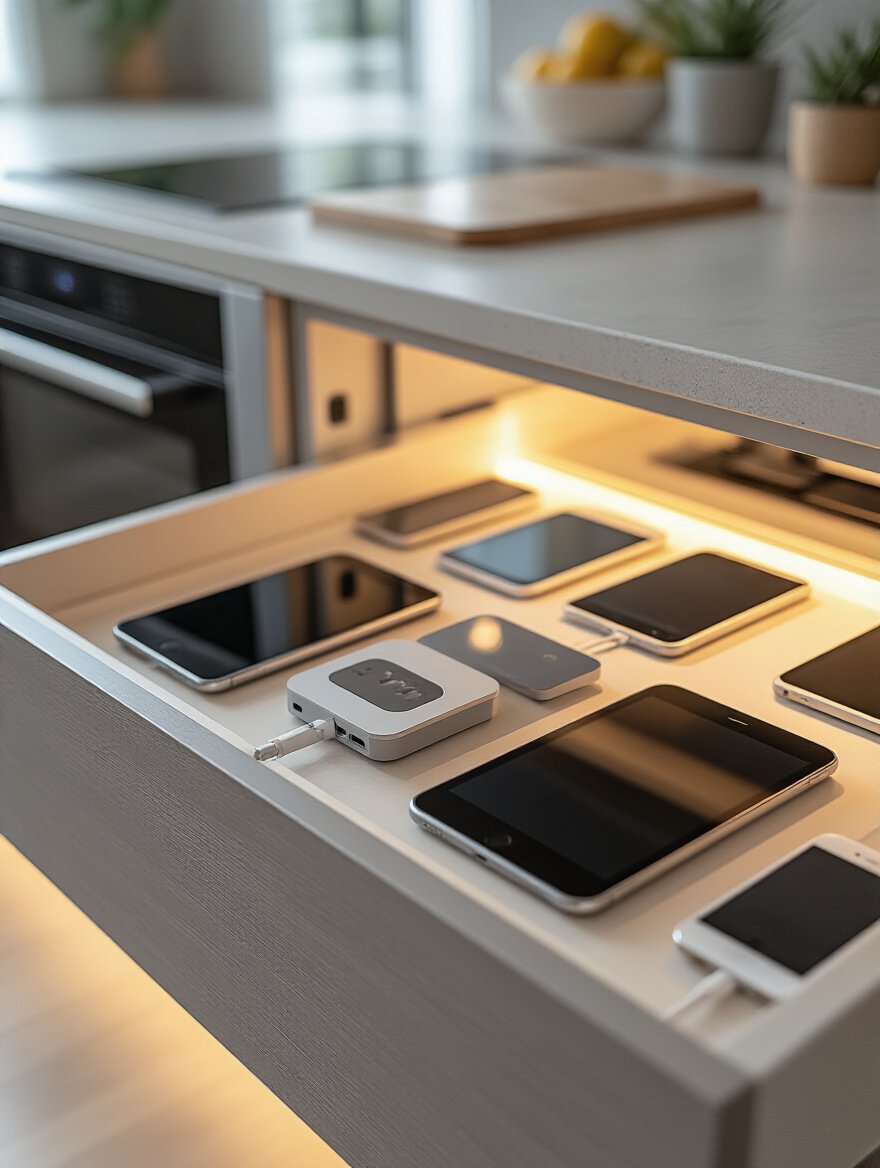
This isn’t just about being tidy. It protects your expensive electronics from the inevitable spills and splatters of a working kitchen, extending their lifespan. You can also add simple, battery-operated motion-sensor LED lights inside deep pantry or base cabinets. The light pops on when you open the door, illuminating the contents so you can find what you need instantly. It’s a touch of high-tech convenience that makes a world of difference.
And finally, the most important habit of all.
18. Implement Easy Cleaning Routines: Preserve Cabinet Longevity and Appearance
I have to end with this, because it’s the key to making all your hard work last. You’ve invested time and thought into creating a beautiful, functional space. Don’t let it get ruined by a buildup of grease and grime. The most sustainable cabinet is the one you maintain so well that you never have to replace it. This means developing simple, consistent cleaning habits.
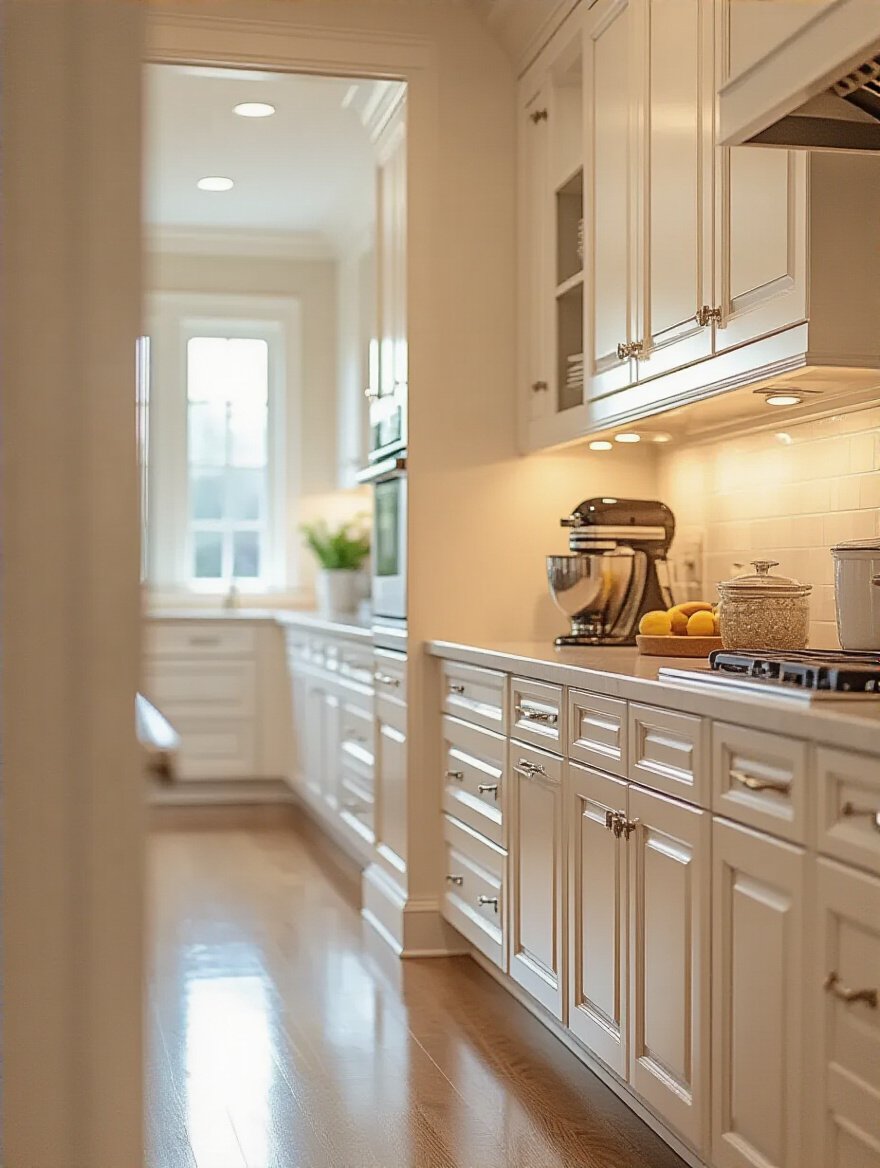
Forget harsh, toxic chemical cleaners. They can strip the finish off your cabinets and are terrible for your indoor air quality and the environment. All you need is a soft microfiber cloth and a gentle solution of warm water and a few drops of mild dish soap. Wipe up spills as they happen. Do a quick wipe-down of high-touch areas weekly. This simple routine will prevent the corrosive buildup that degrades cabinet finishes over time, preserving the beauty and integrity of your kitchen for decades.
Your Kitchen, Reimagined
So there you have it. This is the path to a kitchen that truly serves you. It’s not about demolition and massive budgets. It’s about smart, conscious, and sustainable choices. It’s about seeing the hidden potential in your current space and unlocking it, one strategic step at a time. The result is more than just an organized room—it’s a calmer, healthier, and more efficient heart of your home.
Don’t get overwhelmed. Just pick one. Pick the thing on this list that annoys you the most about your current kitchen and tackle that this weekend. Whether it’s decluttering a single drawer or installing one pull-out shelf, that one small victory will create a ripple effect. You’ll prove to yourself that a better kitchen isn’t a distant dream; it’s right there, waiting for you to bring it to life.
